
One of my biggest fears about discussing the design and materials of a Bible is one of idolatry — I deeply fear missing the point and being more excited about the physical book than the depth of the masterpiece inside.
A friend of mine insisted that a focus on the materials and design of the Bible does not constitute idolatry, so long as that is the focus.
I’ll take his word for it.
So I say this completely ignoring all of the unbelievable material inside: Crossway’s top-of-the-line ESV Heirloom Study Bible is the closest thing this planet has seen to the perfect textbook.

The fact this Bible costs only $375 — and you’ll most certainly find it for cheaper on Amazon or EvangelicalBible.com — somewhat exemplifies our innate ability to overvalue our own words. Were a professor’s textbook to carry this amount of information, this amount of knowledge, this amount of wisdom, in but 2,752 pages, the textbook would cost thousands of dollars.
I purchased Crossway’s ESV Heirloom Study Bible just a short while after being baptized in March 2019. The lead time up to my baptism was full of reading, prayer, and conversation with those who had already taken the path I was walking. During that time, most of my learning was done through listening and asking questions.

But as anyone else will attest to, the days after baptism lead to a return to normality — and even one of attack. Things will be different, sure, but almost all your lifelong habits are bound to return.
And so I went looking for something to guide me through the Bible. Prayer works, of course. But having some extra footnotes and graphics to foster some new interpretations should only help deepen an understanding.
Note: Although I allude to the fact I have a few other Bibles on my desk awaiting review, I indeed purchased the ESV Heirloom Study Bible at full price for my own purposes. The opportunity to review other Bibles only arose after my purchase.
Design and Materials
Crossway’s Study Bible has been around since 2008 and is widely believed to be the best study Bible available today. The ESV Heirloom Study Bible debuted in the latter half of 2018 and was printed to commemorate the ESV Study Bible’s 10-year anniversary. Crossway pulled the double whammy when selecting printers and binders for the Heirloom Study Bible: L.E.G.O. in Italy, one of the world’s most renowned printers, completed the Study Bible’s printing, while the equally famous Royal Jongbloed binders in the Netherlands bound the Study Bible.

The result is nothing short of stunning.
Goatskin Leather

The Heirloom Study Bible’s goatskin leather is soft, supple, and wonderfully pliable, ensuring you can bend the cover this way and that without worrying about breaking the cover. This goatskin leather is very much like the 80th Anniversary ESV Omega,1 but is a tad stiffer than the Omega’s cover.

Of note, the Heirloom Study Bible’s goatskin leather cover has a more subdued grain than the ESV Heirloom Single Column Legacy which I reviewed last year. The Single Column Legacy’s cover has effectively set my expectations for what a goatskin leather cover should look and feel like, so I was quite surprised to see the Heirloom Study Bible’s cover to be so different. In short, the Study Bible’s cover has a more subdued grain, with a thinner feel. The Single Column Legacy’s cover feels more “bubbly”, in a way.

The outer edge of the goatskin cover is perimeter-stitched, reinforcing the cover and providing an extra level of durability for the lifetime of the Bible. All the highest-end Bibles have perimeter-stitching these days, so this was to be expected.
In typical Crossway Heirloom Bible fashion, there are no logos or debossings on the front or back covers of the Heirloom Study Bible. Schuyler’s Jerusalem Cross is a one-of-a-kind debossing, but I prefer this understated, conservative look.

The inside cover is made of an edge-lined leather that feels like calfskin, although it may very well be something more artificial to ensure long-term durability. The edge of the inside cover is gilded, and the entire inside cover is Smyth-sewn — not only ensuring greater long-term durability, but the Smyth-sewing also ensures proper flat-lay when the Bible is open.

The simplicity of the exterior covers continues into the inside covers — there are no adornments aside from a “Goatskin Leather” marking on the inside back cover.
Spine
Of all the exterior design elements that draw my attention to a Bible, it’s the spine that’s the first element to catch my eye. I used to think there wouldn’t be a Bible that could top the Single Column Legacy’s spine, with the many raised ribs and heavily textured goatskin leather. Schuyler’s Quentel lineup of premium Bibles has indeed surpassed the Single Column Legacy’s spine in my opinion, with its simple raised ribs and less obtrusive logos.

The ESV Heirloom Study Bible lands somewhere between the Single Column Legacy and Schuyler’s Quentel — it takes the best of the Single Column Legacy and eliminates one of the non-value-added “English Standard Version” logos, but it falls short of the Quentel due to its use of “Study Bible” near the top.
Now, don’t get me wrong, this is a “Study Bible” after all — there are 1.1 million additional words alongside the 757,000 words in the actual Bible. For all intents and purposes, this is less a “Bible” and more “Man’s Interpretation of the Bible”.
But as we’ll see, there’s much done in the way of ensuring God’s Word standing out over man’s word throughout the printing of this Study Bible, and I think Crossway could have used “Holy Bible” at the top of the spine.

This doesn’t mention the choice of font for the “Study Bible” marking — I’m not a particular fan. Maybe the font choice will grow on me over the years.
Size
You can do the math — and if you can’t, you can surely see in these photos — that the Study Bible’s additional 1.1 million words makes for a huge block of text.
The ESV Heirloom Study Bible’s actual paper block measures in at 6.5” x 9.25”, with the front and back cover overhang (the yap) extending about a half an inch further.
That yap is neither too small or too large — I feel it’s perfectly sized. Bibles from R.L. Allan generally have an extra-large yap (which some prefer), and even Crossway’s 80th Anniversary ESV Omega has a slightly larger yap than the Heirloom Study Bible. The yap is just big enough to show off that art gilding around the inside covers when the Bible is closed.

The 2,752 pages measure in at 2.25” thick, making this a large block of paper worthy of manning your desk.
The sheer size of the Heirloom Study Bible almost surely renders this as a desk Bible — I’m not sure I have a messenger bag deep enough to carry the Heirloom Study Bible to the coffee shop and back.
In fact, I envision a specific “Bible-desk” in my dream home, complete with some fine writing instruments, Tomoe River notebooks (these Hobonichi Techo Plain Notebooks are particularly great), an Anglepoise lamp, and a little angled stand for the ESV Heirloom Study Bible. This Bible is large enough to deserve its own permanent throne.
Binding and Hinge
As mentioned, the ESV Heirloom Study Bible was printed in Italy by L.E.G.O. and bound by Royal Jongbloed in the Netherlands, ensuring an unprecedented level of quality.
But not all bindings are equal, even when they’re bound by Royal Jongbloed. I have an ESV Schuyler Quentel on my desk waiting to be reviewed, and that Royal Jongbloed binding is significantly different than the Royal Jongbloed binding of the ESV Heirloom Study Bible.
The Schuyler Quentel’s hinge is more sturdy near the gutter of the paper block, making the gutter significantly more pronounced than the Study Bible. In fact, when reading with overhead light just off to the side, I’ve found the Schuyler Quentel’s gutter to actually produce a shadow, making text in the gutter difficult to read.


Not so with the Heirloom Study Bible. The sheer size of the Study Bible has an impact on the size and depth of the gutter, but the Heirloom Study Bible’s hinge lays more flat than my Schuyler Quentel copy. The Study Bible lays flat from the beginning introduction papers through to the concordance at the end, and only improves as you wear in the Bible. Plus, the way each page is formatted in the Study Bible ensures you don’t need to read into that gutter as often.
Paper
It’s a book after all, right?
But when broken down from the sum of its parts, paper is the single element you will interact with most when reading through a book. And there’s a few unique features in the ESV Heirloom Study Bible that really set it apart from Crossway’s other Heirloom Bibles.
Thickness and Opacity
At nearly 2 million words, plus hundreds of graphs, images, charts, and maps, it’d be easy for the ESV Heirloom Study Bible’s thickness to get out of hand. Even at 2.25” thick, some might consider this thickness over-the-top.
Combatting that thickness is a 31 GSM Thincoat Plus paper, thinner than the 36 GSM paper found in the Schuyler Quentel, but thicker than the 28 GSM Indopaque paper found in the Heirloom Single Column Legacy.

As expected, the opacity level of the 36 GSM paper in the Schuyler Quentel is much higher than the Study Bible. There will always be show-through in Bible paper, but there’s quite a difference between 31 GSM and 36 GSM paper.
What’s interesting is the opacity of the 28 GSM Indopaque in the Single Column Legacy. When I put the Heirloom Study Bible and Legacy side-by-side, the opacity of the Single Column Legacy really stands out — between the perfect line-matching and off-white colouring, the Single Column Legacy provides significantly less show-through than the Study Bible.
Not only that, but the 28 GSM paper in the Single Column Legacy even feels thicker to the touch, even though it isn’t.

All this to say, the Heirloom Study Bible’s paper feels thinner than it actually is, has less opacity than you’d expect considering its GSM specification, and this all contributes to a greater amount of show-through and ghosting. These compromises are made to keep the thickness of the Study Bible at bay — which I’d say comes in successfully, with a wide range of pros and cons.
Paper Colour
One of the big contributors to this show-through is the colour of the Heirloom Study Bible’s paper. The Study Bible employs a whiter paper than the Single Column Legacy — where the Legacy’s paper looks very creamy, the Study Bible’s paper looks bright white.

I expect this is due to the variety of other colours printed in the Study Bible’s contents. Footnote summaries are printed with a washed-out green background and images and maps are printed in full colour — were these to be printed on a cream-coloured paper, colours may not come true (or, rather, truer) to life than on a white/blue paper.
But consequently, black text on a whiter-white paper exacerbates show-through, especially in the footnote section of each page. Again, there’s nothing to worry about here, but there’s a noticeable impact of the decision to use a bright white paper.
Ribbons

Like all the other Crossway Bibles on my desk, the Heirloom Study Bible comes with four multi-coloured ribbons. The black, brown, saddle brown, and tan coloured ribbons provide a nice variety, if you’re into marking colour-coordinated spots in your Bible.
However, unlike the Single Column Legacy and ESV Omega, the Study Bible comes with thicker, wider, and substantially better quality Berisford ribbons. These appear to be the same ribbons as those in the Schuyler Quentel series.


Many have suggested the Study Bible’s Berisford ribbons are too short — when pulled to the corner of the book block, the ribbons just barely extend past the page, making it difficult to spread out your ribbons.

But I’m fairly certain you can make ribbons too long as well. The Quentel’s ribbons extend far beyond the corner of each page, to the point of extending past the edge of your desk if you are reading the Bible at your preferred study table.

I’m not overly opinionated on this matter. I really like the fact Crossway opted for larger Berisford ribbons in the Heirloom Study Bible, I like the multi-coloured display, and I like the clean look of the shorter ribbons. It’d be nice if they extended just a bit further beyond the page though.
Art Gilding

Crossway has sort of commandeered the salmon art gilding colour. I can barely tell a difference between the red-under-gold gilding of the Heirloom Study Bible and either of the Single Column Legacy or the ESV 80th Anniversary Omega. To my eye, the colours look identical.
There are two elements that set apart the Heirloom Study Bible’s art gilding, however.

First, the Study Bible’s art gilding is meticulously crafted. It’s perfect — the colouring is evenly applied across all the page edges and the colour is consistent no matter the page spread.
Further, there’s no gilding bleed to be found in the Heirloom Study Bible. I’ve found fairly significant gilding bleed on my copy of the ESV Quentel and even Crossway’s own 80th Anniversary Omega. (I haven’t been able to find it in my Single Column Legacy, mind you.) Perhaps this type of detail is what sets the Heirloom line of Bibles apart in Crossway’s lineup.

Second, the Study Bible’s art gilding looks very, very “gold” in the right light. Perhaps it’s the method in which colour was applied to these photos. Perhaps it’s the particular colour of the lighting when I shot the photos. Regardless, this art gilding looks like goatskin leather is covering a solid brick of gold.
Printing
My experience with premium Bibles is somewhat limited, as I have to admit this was the first time I’d heard of the L.E.G.O. printers in Italy. But with a little experience under my belt, I can see why L.E.G.O. has become world-renowned for its premium printing capabilities.
Regardless of the printers, this is Crossway’s own 2016 ESV Study Bible material, so many of the design decisions, font decisions, colouring and map decisions, and more were all already applied in their previous non-Heirloom Study Bible edition. By and large, the insides of the Heirloom Study Bible may be similar to other Study Bibles on the market. In this case, it’s the physical materials and specific attention to detail that help this Bible dawn the Heirloom title.
Font, Font Sizes, and Layout
As there are more human words injected in the Study Bible than God’s own words, Crossway opted to delineate man’s word and God’s Word through different font sizes.

Across the Study Bible, divine words are printed in 9 pt. Lexicon font, with notes being printed in a 7.25 pt. Frutiger and Helvetica font. Some articles at the beginning of the Study Bible utilize the larger 9 pt. font for human words, however all articles in the back utilize the 7.25 pt. font.
Legibility at these two font sizes will vary depending on the reader’s eyesight and their context. The larger 9 pt. font is easy to read and consume, while I find myself having to look a tad closer at the 7.25 pt. note font to ensure I’m reading everything correctly. I understand the decision-making process and actually find the decision quite reasonable, but there will be some who must use their eyeglasses to consume the notes. (Almost everyone will need glasses to read the concordance — the typesetting here is absolutely miniscule.)
The 7.25 pt. font really bugs me in the human articles at the back of the Study Bible, though. Again, the decision to set divine and merely human words apart by font size makes sense, but these scholarly articles in these small fonts are the hardest reading pill to swallow in the Study Bible.
I’m not a type designer, but I do know a designer who is pretty particular about line height. When I showed him the individual Bibles I had waiting to be reviewed, he marvelled at the Single Column Legacy’s line height and giggled at the 80th Anniversary Omega’s line height. He was neither here nor there in regards to the Study Bible’s line height — I presume this means he was happy with it.

My gripe about font sizes most certainly doesn’t extend to the Study Bible’s layout. Divine words are split out in the top section of the page in a single column format, a lá the Single Column Legacy. Notes and images take up the remainder of the page at the bottom and are split in a double-column format.
Note discussions do a very good job of adhering to the page of its root verse (meaning Job 10:21-22 will have a note on the same page, not on the reverse page), to the point that I become baffled at how Crossway was able to keep everything so well aligned.
Cross-references — over 80,000 of them — end up in the inside margin of the book block. These cross-references are printed in very tiny type and require extra close inspection. However, with all the notes at the bottom of each page highlighting the most important cross-references, I haven’t yet found myself really delving into the gutter-based cross-references.
Those cross-references are noted with cross-reference keys in-line with the text, but they’re so small I hardly ever find myself distracted by them. They’re printed in a slightly lighter font as well, helping them to blend into the background beside the heavier text on white/blue background.
Line-Matching
Line-matching is a printing practice that ensures lines of text lineup exactly with a line of text on the reverse page, helping to eliminate show-through and ghosting and eliminating distractions when reading. Because the Single Column Legacy so gracefully implemented line-matching, I actually assumed this would be a standard printing practice on all Crossway Heirloom Bibles.

But there’s likely good reason the Heirloom Study Bible can’t implement perfect line-matching. For one, there are images and graphs strewn across the Study Bible materials, pushing lines of text into all sorts of different areas on the page. Second, notes in particular utilize background printing, placing a block of ink across multiple lines.
I feel the Heirloom Study Bible would have had to make too many compromises to garner a “line-matching” feature in its tech spec page. Eliminating graphs, charts, and background printing all for the sake of line-matching would have limited the ability of the study contents to shine.
Black-Letter Typesetting
Despite the Study Bible nature, the Heirloom Study Bible employs a black-letter typesetting only — words of Christ are printed in black and not in red.
I prefer this, as red lettering implies one word is worth more than a black word (when in reality we are to believe the entire Bible is the Word of God). Plus, red lettering is distracting and very easy for printers to mess up.
Admittedly, I do utilize red font in my own study notes to delineate the words of Christ. Why? To make my study faster. Red lettering = Christ’s words. Easy to remember when I’m trying to study. But when reading, I prefer black lettering.
Study Materials and Extras
It’d be very easy to delve into each individual extra inside the Heirloom Study Bible, from the scholarly articles, to the images to the reading plans, and the massive concordance. It’d also be quite easy to plant an opinion on these scholarly articles, even sub-consciously.

As a result, I’m mostly going to list the contents of the extras without diving into any discussion on the topics. My personal favourite scholarly article is the Biblical Ethics Overview in the back, as it provides Biblical direction on many of the most difficult issues of the day. However, each article may touch each studier differently.
ESV Study Bible 2016 Version
As mentioned earlier, this is the 2016 version of the ESV Study Bible, making the contents 3 years old at the time of writing. Biblical study and scholarly work likely doesn’t change at the pace of the technological devices I review regularly, so I’m not too concerned about the dating of the 2016 material.

However, this isn’t to say that new information and new scholarly work doesn’t come to light over the next 30 years. And this plays a role on the whole “Heirloom” moniker.
These Bibles are designed to be passed down to the next generation as an heirloom. But with more than half of this Bible’s content likely to be updated at some point during the rest of my life, this Heirloom Study Bible could quickly become a “period of my life” Bible. I wouldn’t be surprised at all if a 2035 ESV Heirloom Study Bible ended up on my desk in the future.
This carries a few impacts.
One, spending a large amount of money on this Study Bible may require spending another large sum of money in the future when the contents are updated. So, there’s a monetary impact.
Two, the Study Bible likely inherently carries the consequence of being tailored to the times. The Word of God is inherently good and true, across all times, contexts, and eras. For all the notes and articles to be tailored to the times (think Biblical ethical discussions today that become answered dilemmas decades from now), I fear this type of Bible may be impacted too much by the news of the day.
Three, more positively, the Heirloom Study Bible can be more easily written in, highlighted, and more, as it’s likely your markings are going to evolve throughout your life. This Heirloom Study Bible could contain your spiritual journey for the first 20 years of your life, with an updated Heirloom Study Bible containing the second half of your spiritual life.
(Turns out, I added some personal anecdotes. I tried not to. Didn’t work.)
Footnotes
I try to follow a Bible reading plan, working my way through specific themes of each weekly or monthly plan. The best practice I’ve found so far is to read the passage in its bare words in a separate Bible and then re-read the passage in the ESV Heirloom Study Bible while simultaneously consuming the footnotes on those passages at the bottom of the page. This has helped my understanding of the text immensely and provides ample time to ponder the passage without any impact from scholarly minds.

That said, I find the Study Bible’s footnotes to be absolutely invaluable. The footnotes really aim to provide context to the words in the Bible — often, these footnotes will discuss what specific words meant when the Bible was written, contexts and situations around a specific passage that help to provide clarity beyond a simple translation, and link common themes across multiple verses or books. This is particularly fascinating in Paul’s epistles in the second half of the New Testament, where we can see common themes form across multiple letters.
Of course, there are also graphs and images and charts to consume in those footnotes as well. I haven’t found images to be too helpful in my study, however other visual learners may find these images to be of the utmost importance.
Book Introductions

Each book in the Heirloom Study Bible begins with an introduction outlining a variety of details in the book, such as:
- Author and title
- Date
- Key theme(s)
- Purpose, occasion, and background
- Literary features
- Structure
- History of salvation
- Outline of the book
Most of all, these introductions provide a context in which to read the book and provide some context around some of the key phrases, key words, and some translational decisions made in order to make the book readable in English.

There are also introductions for major sections of the Bible, such as an introduction to the Pentateuch, an introduction to the Historical Books, an introducing to the Poetic and Wisdom Literature, and an introduction to the Prophetic Books. There’s even an introduction to both the Old and New Testaments themselves, along with a scholarly article discussing the timeframe between the Old and New Testaments.
It’s not that human words are more interesting than God’s Word, but I find these introductions to be extra interesting. If you’ve grown up with the Bible, these books feel like old hat sometimes. These introductions provide just enough context to read the respective book with a new set of eyes.
Scholarly Articles
After Revelation 22, there are a plethora of scholarly articles in the Heirloom Study Bible for you to read at your own pace. Of the 1.1 million extra words, I’d wager the majority of them are housed in these articles.

These articles were created by a team of 95 scholars and teachers from across the globe, spanning 9 countries, 20 denominations, and 50 seminaries, universities, and colleges. As Crossway puts it, the ESV Heirloom Study Bible contains the equivalent of a 20-volume Bible resource library. To say these tools are extensive would be an understatement.
The following scholarly articles and resources are provided in the back of the Heirloom Study Bible, all of which are broken into further parts in the table of contents:
- God’s Plan of Salvation
- Biblical Doctrine: An Overview
- Biblical Ethics: An Overview
- Interpreting the Bible
- Reading the Bible
- The Canon of Scripture
- The Reliability of Bible Manuscripts
- Archaeology and the Bible
- The Original Languages of the Bible
- The Septuagint
- How the New Testament Quotes and Interprets the Old Testament
- The Bible in Christianity
- The Bible and World Religions
- The Bible and Religious Cults
- History of Salvation in the Old Testament: Preparing the Way for Christ
- Colophon
- Maps
These scholarly articles are what you purchase the Study Bible for. These pieces of human words provide an extraordinary amount of extra research, knowledge, and context around God’s Word, and they help to provide both answers and direction on how the Bible applies to all points to history.

Importantly, these scholarly articles are generally overviews and not in-depth discussions. You can purchase an entire Bible dedicated to understanding archaeology and the Bible, so the article provided in the Study Bible aims to provide some general insight into the topic.
Daily Bible Reading Plan
I find daily Bible reading plans to be overwhelming. Those who have not just the time but the energy to digest such a deep amount of knowledge will benefit from a daily Bible reading plan being built right into the back of their Bibles.
But for everyone else, who find themselves exhausted at the end of a day of running after toddlers or teenagers, the built-in reading plan can be walked through at a much slower pace than a one-year plan.
I prefer theme-based reading plans (I enjoy the weekly reading plans found in the Olive Tree Bible Study app), but Crossway’s reading plan is designed to give you a daily dose of each area of the Bible:
- Psalms and Wisdom Literature
- Pentateuch and History of Israel
- Chronicles and Prophets
- Gospels and Epistles
Again, to each their own — these reading plans will fit some and not fit others. If you’re looking for a theme-based approach, check out an app like Olive Tree Study Bible instead.
Concordance

The Heirloom Study Bible’s concordance may very well be the best in the business. It spans 77 pages and has 3 columns per page, with entries and proper names highlighted in all-caps and bolded font and where you can find the entry used in a lighter font.
The vastness of this concordance is almost overwhelming. If you’re looking for a term, it’ll be here. There is almost an entire column of references for the term “God”, 17 different references for the term “Christ”, and another 36 references to the term “Faith” highlighted in this concordance.
And should you need more than the provided concordance, Crossway recommends you consult the ESV Comprehensive Concordance of the Bible, which has more than 300,000 verse listings for 14,000 different words.
Maps

The ESV Heirloom Study Bible’s maps are printed on a heavier paper than the rest of the 31 GSM book block — you can feel them instantly when you reach the end of the Study Bible. I understand the decision — the large amounts of coloured ink printed on these pages would surely show through and skew the maps on the reverse side of the page.2
I do find the Heirloom Study Bible’s maps to be a bit bland in colour, however. When placed beside the Schuyler Quentel maps, all the pastel colours used for the Study Bible’s maps end up looking washed out and dated.

This being said, there are a ton of maps in the Study Bible. Near the end of the Study Bible, you’ll find a list of all the maps strewn across the footnotes and introductions, and there are also 16 additional maps printed on the heavier paper in the back.
Price
So, what are all of these study tools, high-end materials, and extreme attention to detail going to add up to when you ring the cash register?
Understandably, this isn’t an inexpensive Bible.
Retail price of the ESV Heirloom Study Bible comes in $375 USD if you purchase directly from Crossway. Considering Crossway is a not-for-profit ministry, this is a great way to not only spend your money on a high quality Bible, but also a chance to support a great organization.
If you’re looking to get your hands on the ESV Heirloom Study Bible for less, well, you’re in luck. You can purchase the Heirloom Study Bible on a variety of online stores for a variety of prices. At the time of writing, you can purchase the ESV Heirloom Study Bible at:
For an additional few dollars, you can purchase a Vintage Brown and Ocean Blue colour-way at EvangelicalBible.com.
I alluded to this at the top: The fact this Bible only costs $300 (or less) is a shining example of how we overvalue our words in today’s day and age. I purchased post-secondary textbooks for double this price tag a few years ago, and those books contained a quarter of the words and a fraction of the wisdom of the Heirloom Study Bible.
Is the price for the ESV Heirloom Study Bible fair? Absolutely, 100%.
Update — Crossway's Heirloom Study Bible in Calfskin Leather
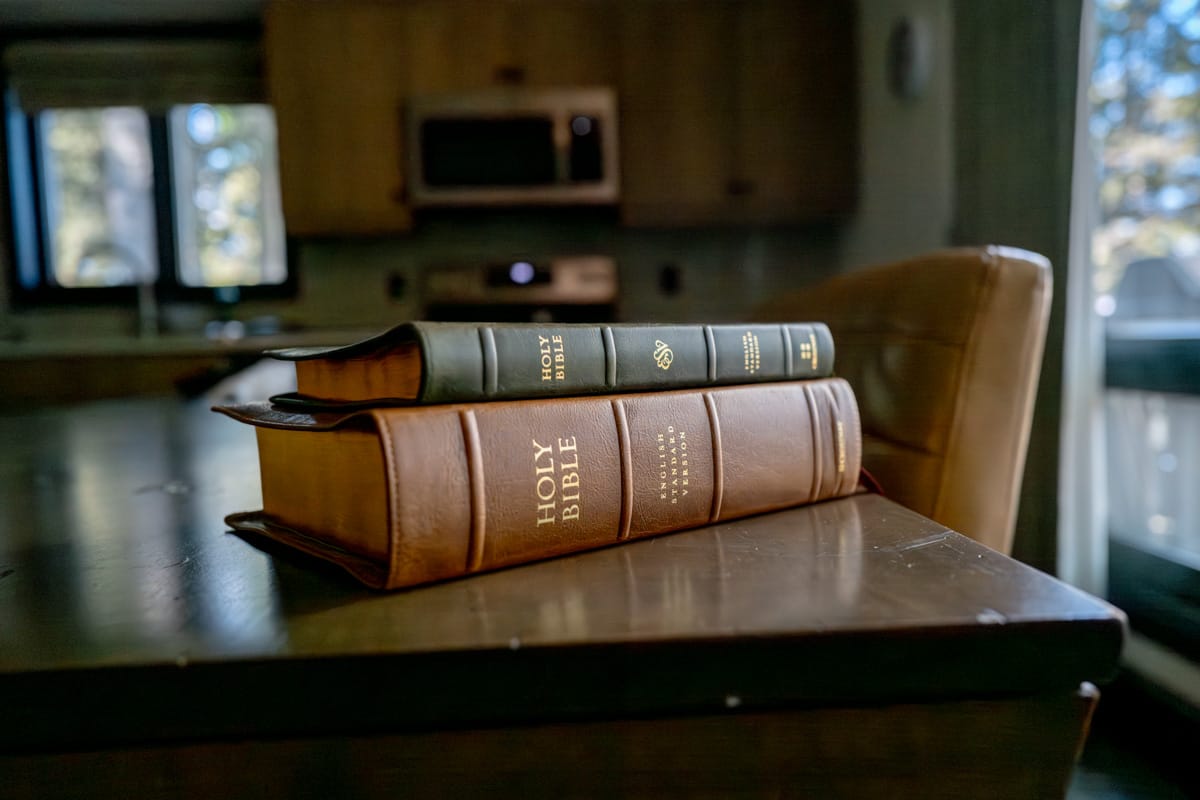
It's crazy to see this review of the Heirloom Study Bible was published all the way back in July 2019. So many things have changed and happened since that time.
One thing that hasn't changed is the Heirloom Study Bible, however. Crossway still produces one of the best study Bibles on the market and has continued to collaborate with other Bible makers to come up with enhancements and improvements to its original goatskin leather Heirloom Study Bible.
After hemming and hawing for a lengthy period of time, I picked up one of Crossway and Evangelical Bible's Heirloom Study Bible collaborations in Desert Camel calfskin leather for my wife to enjoy. The Heirloom Study Bible has been one of the core physical tools of a transformative few years of prayer and study and I'm so glad my wife has one of her own to dive into as well.
Crossway and EVBible have done a great job finding areas to improve the original Heirloom Study Bible. So many of the negative elements of my original review have been addressed. From ribbon length to paper colour to spine branding, Crossway and EVBible have completely outdone themselves with this calfskin leather Heirloom Study Bible.
Quick Preface
And! — In my most recent Bible review of the Heirloom Single Column Personal Size Bible (in which I was overly negative and completely ashamed to have even published the review), I lamented Crossway's decision to move production of their Heirloom-level Bibles to China. That personal size Bible was the first run of Crossway's Chinese-produced Bibles. The quality was horrible. I struggled to find one element of that small personal size Bible to celebrate. I couldn't think of a worse value Bible to purchase at that time.
It turns out Crossway continued at least some production in China. This calfskin leather Heirloom Study Bible was printed in China by R.R. Donnelly & Sons, an American company with headquarters in Chicago, Illinois.
But I didn't realize this Heirloom Study Bible was produced in China until weeks after receiving it. Throughout these first few weeks, I've admired from afar how well Crossway found minor issues with the goatskin leather Heirloom Study Bible and corrected them. Now, after learning this was produced in China, I'm even more impressed with Crossway's ability to address its mistakes in years past.
This calfskin leather Heirloom Study Bible is nothing like that first run Heirloom Personal Size Bible. The quality here is unmatched. The fact this calfskin leather Heirloom Study Bible was produced in China should have zero bearing on whether you decide to pick one up. You simply won't notice anything that might convince you it was made with cheaper processes and poorer quality control practices.
Improvements
Below are a list of the differences and improvements I've been able to find when comparing my wife's calfskin leather Heirloom Study Bible to my now six-year-old (used, damaged, loved) goatskin leather Heirloom Study Bible:
Calfskin Leather
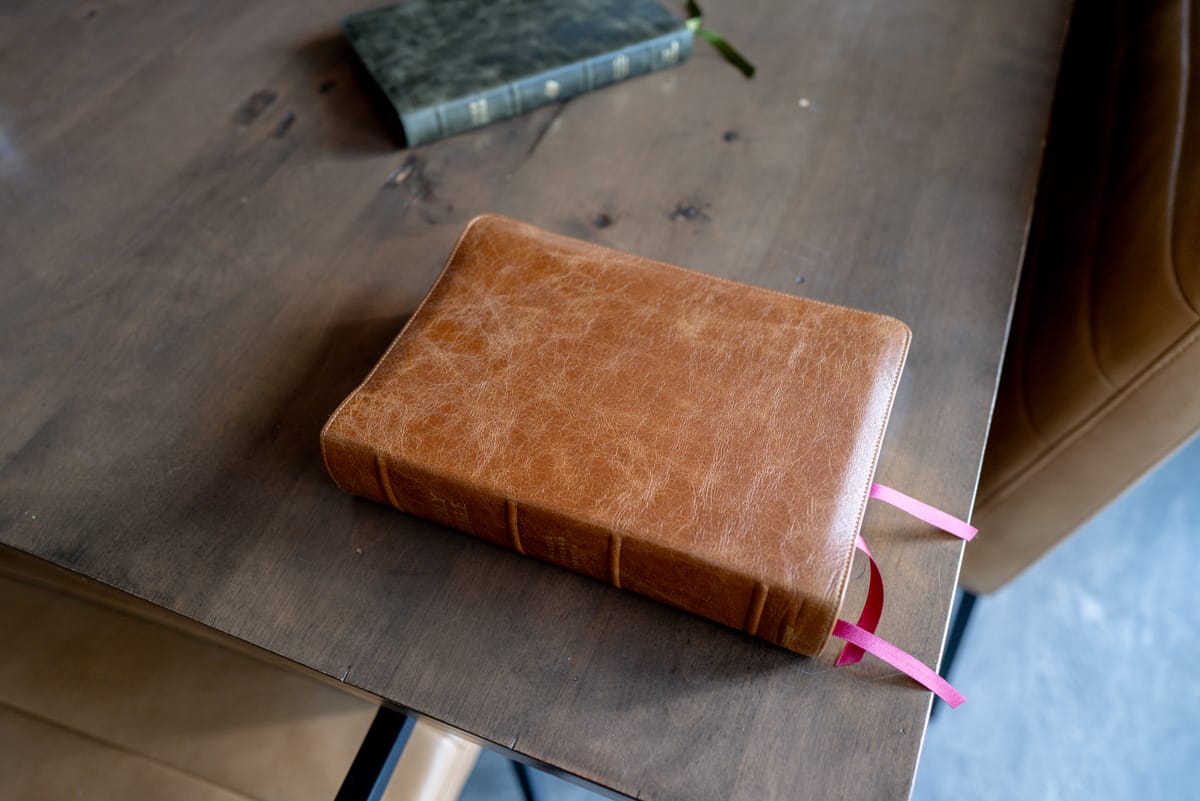
Of course, the most noticeable difference is the newer Heirloom Study Bible's calfskin leather exterior. Where goatskin leather is somewhat "bubbly" and malleable, this calfskin leather has a texture and stiffness to it that I wasn't expecting. The leather also has some serious character and is sure to catch an eye at any Bible study where you might pull this out.
The front and back covers are noticeably stiffer. This makes for an easier package to carry around as the leather and book block doesn't bend in on itself. My sense is the stiffness comes from the calfskin leather itself, though it could be the material on the inside cover providing the stiffer experience.
I'm also convinced calfskin leather is lighter than goatskin leather. Most folks won't give review points to a Bible for being lighter than its predecessor, but the calfskin leather Heirloom Study Bible is noticeably lighter than the goatskin leather option. Combined with the stiffer book block, the calfskin leather option is easier to take with you from place to place.
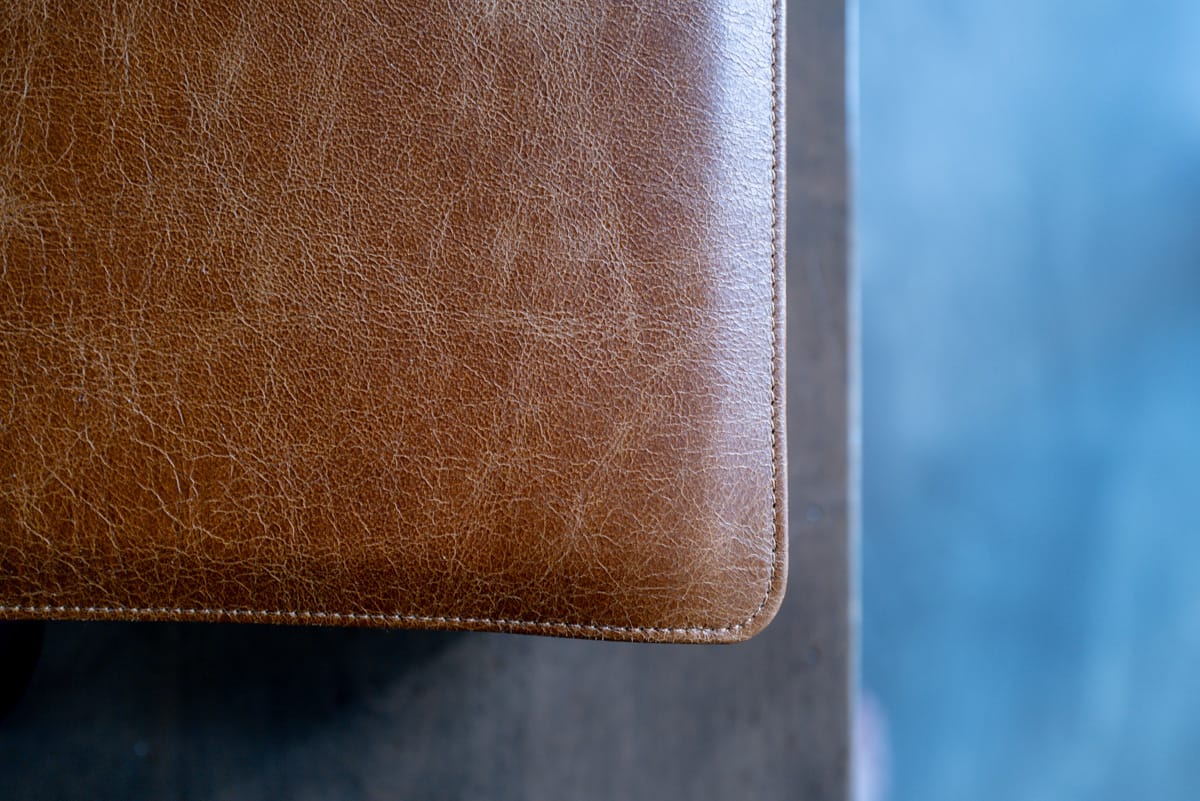
Lastly, this particular calfskin leather has a marbled finish to it, ensuring no two Heirloom Study Bibles are entirely the same. You can even feel some of the texture.
The calfskin leather options coming out of EVBible these days are all magnificent — right now, I'm a huge fan of the olive green calfskin leather, but this desert camel colourway is a close, close second. The brown is a tad more orange or gold than I feel the website colours show. Combined with the wine coloured ribbons, this is a great colourway that will stand the test of time. One day, I'd like to compare this to the new sandstone calfskin leather from EVBible.
Spine
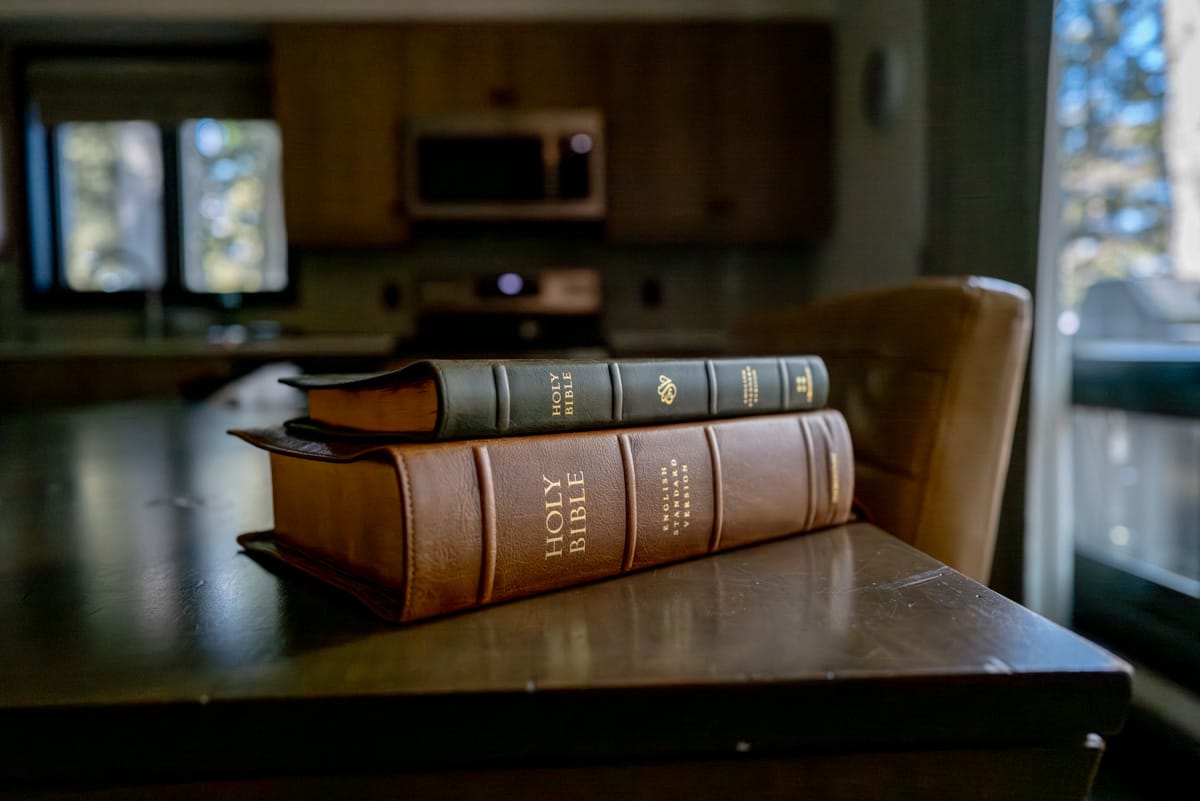
I had two actual complaints about the goatskin leather Heirloom Study Bible, one of which was all the branding on the Bible's spine. Regardless of whether there are study notes inside the Bible, this is a Holy Bible, and the original goatskin model jettisoned the "Holy Bible" in favour of "Study Bible". This calfskin option returns "Holy Bible" to its rightful glory and cuts down the branding to a singular Crossway logo at the bottom of the spine.
Great job Crossway fixing this oversight.
Ribbons
The calfskin Heirloom Study Bible's ribbons are a case of "two steps forward, one step back".
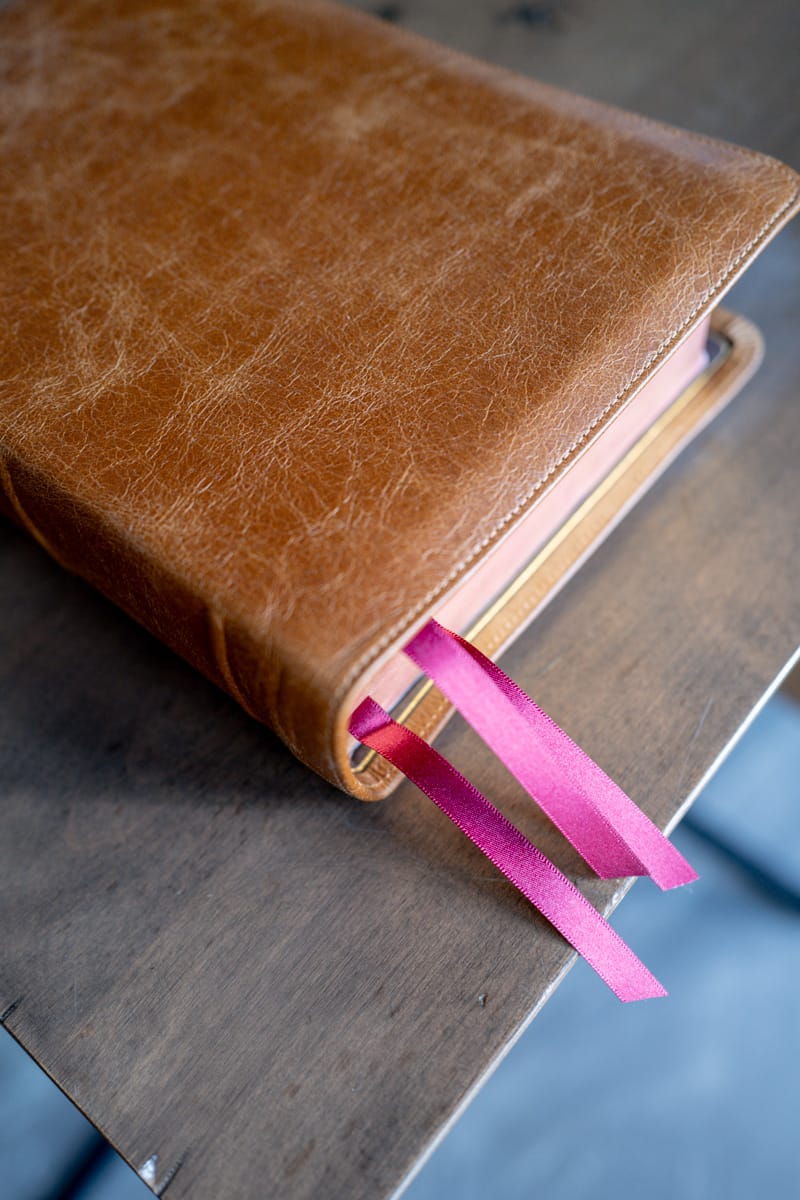
Two steps forward: The calfskin model comes with much longer ribbons and all the ribbons are of one colour. I'm one for consistency and simplicity in design, and having multiple ribbon colours in other Crossway options has always provided yet another way to categorize or organize things. I prefer one single colour here and I especially appreciate the far longer ribbons.
One step backward: Interestingly, Crossway opted to put in only three ribbons in the calfskin Heirloom Study Bible rather than the four ribbons found in the goatskin Heirloom Study Bible. Why this is, I'm not sure. I use all four ribbons in my goatskin option regularly, so having one less would be a detriment, for sure.
Full Yapp
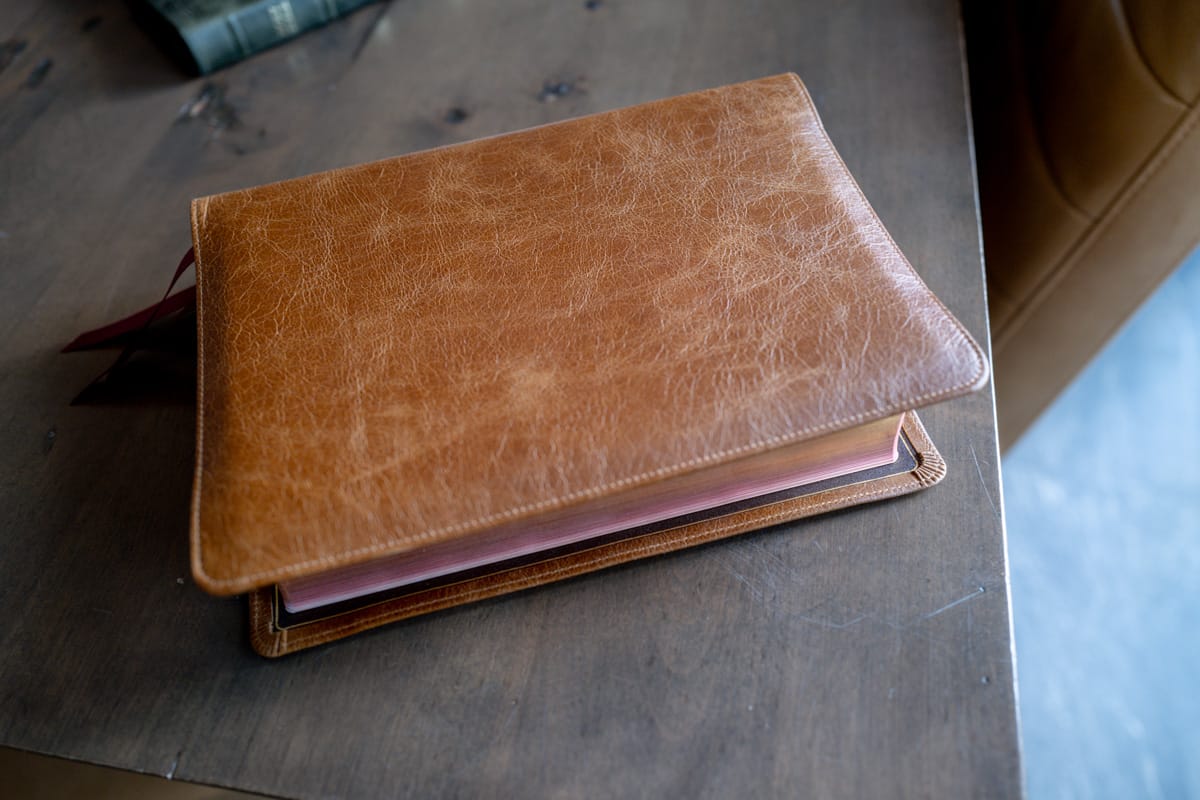
Though the calfskin Heirloom Study Bible is lighter and better for carrying around, I wouldn't want to suggest it is smaller than the goatskin model. This is because of the yapp — the calfskin Heirloom Study Bible has a much larger yapp, providing extra defence against the elements for the beautifully gilded book block.
I'm not sure if you can dub this a "full yapp" Bible, though. I have a new Heirloom Thinline Bible (also a Crossway and EVBible collaboration) and it is specifically noted as "full yapp" in the description. I'd also suggest the Heirloom Thinline's yapp is larger than the calfskin Heirloom Study Bible.
So all in all, perhaps this is a "three-quarter-yapp" model. Either way, it's bigger than the prior goatskin leather option, and makes for a more protected book block.
Paper
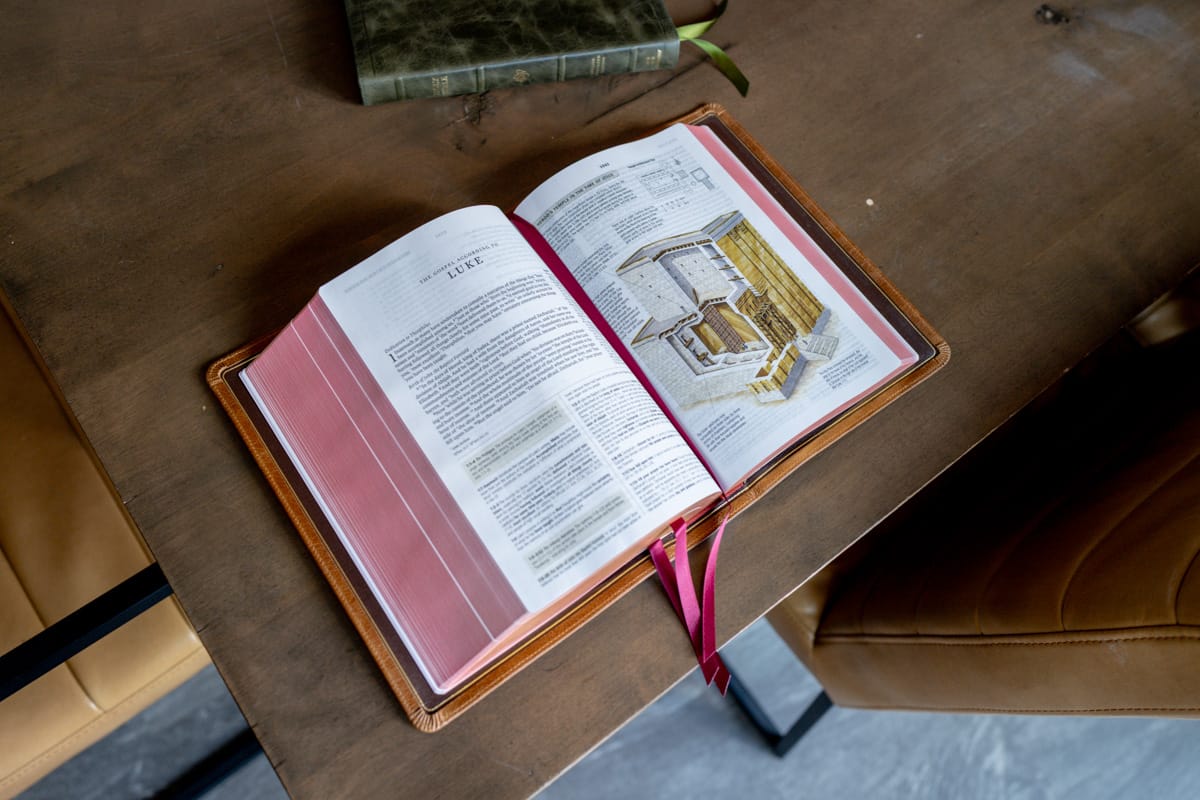
The single most important difference between the goatskin leather Heirloom Study Bible and this new calfskin leather Heirloom Study Bible is the paper. Crossway noticed the single, most impactful negative in the goatskin model and revamped this newer calfskin model, making for not only a wonderful study experience, but also a great reading experience.
The goatskin Heirloom Study Bible had a 31 GSM Thincoat Plus paper. Throughout that Heirloom Study Bible, the paper colour was more of a bright white colour, making for a vibrant study note imagery and a high contrast between the text and the white paper around it. However, that contrast also shows through from the backside of that Thincoat Plus paper, which was especially noticeable when line-matching didn't perfectly align with the backside of the page. In many circumstances, the bright white paper in the goatskin Heirloom Study Bible was harder to read and resulted in more show-through than you may believe for a 31 GSM thick paper.
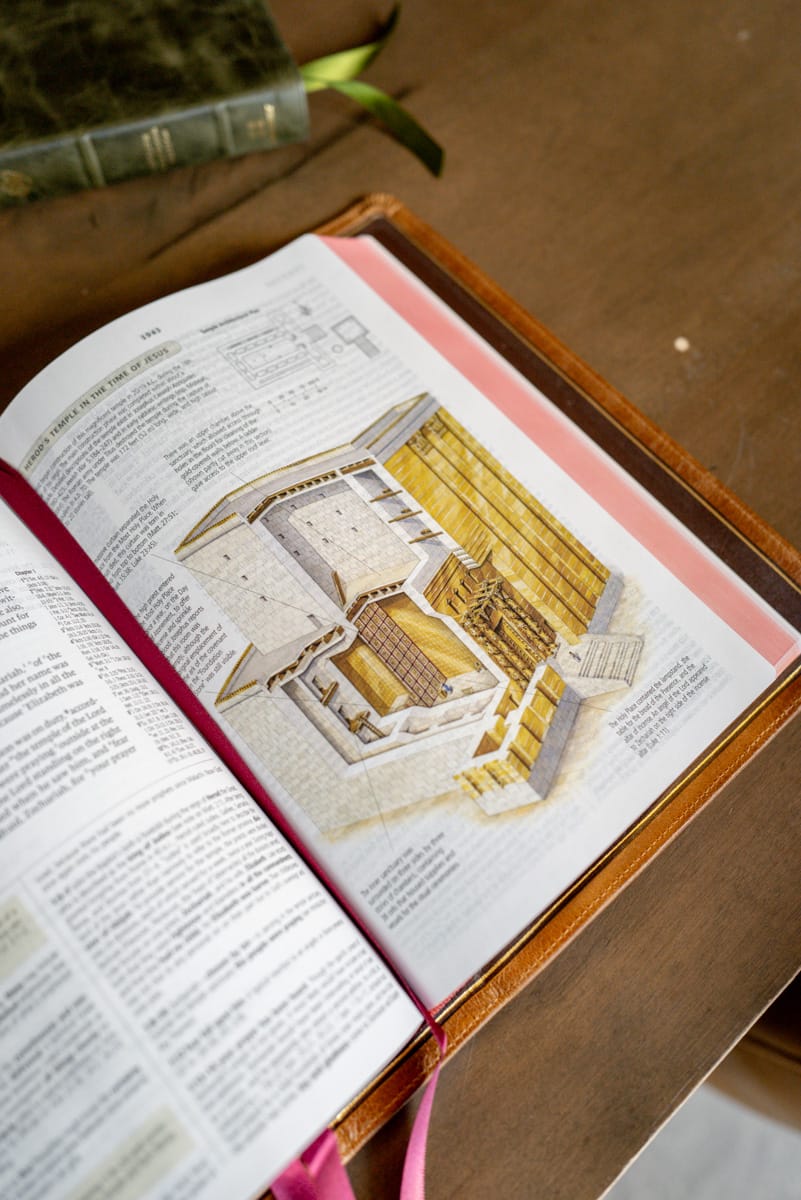
The calfskin model's paper is a 30 GSM Thin Opaque paper, suggesting it is a hair thinner than the goatskin model's paper. However, the paper's off-white egg-shell colouring makes for a substantially improved reading experience and significantly less show-through from the backside. Despite being thinner, this 30 GSM Thin Opaque paper is superior to the 31 GSTM Thincoat Plus paper in so many ways.
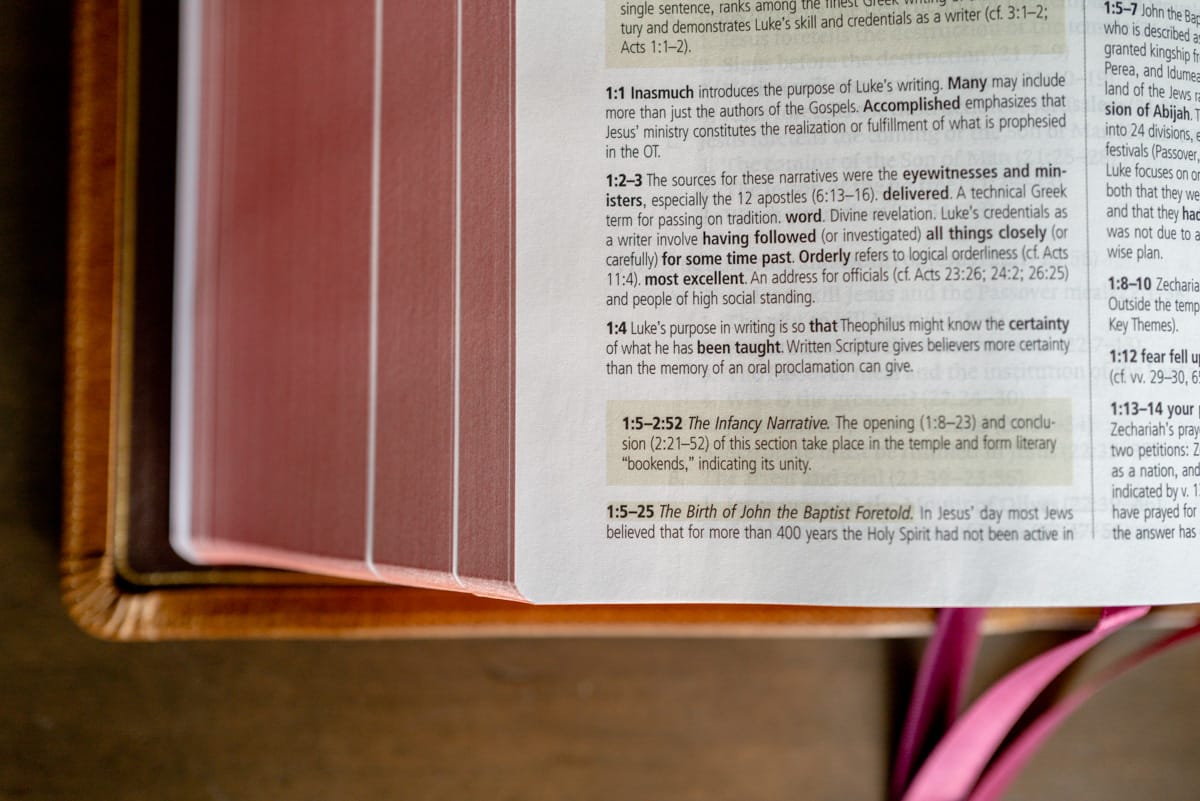
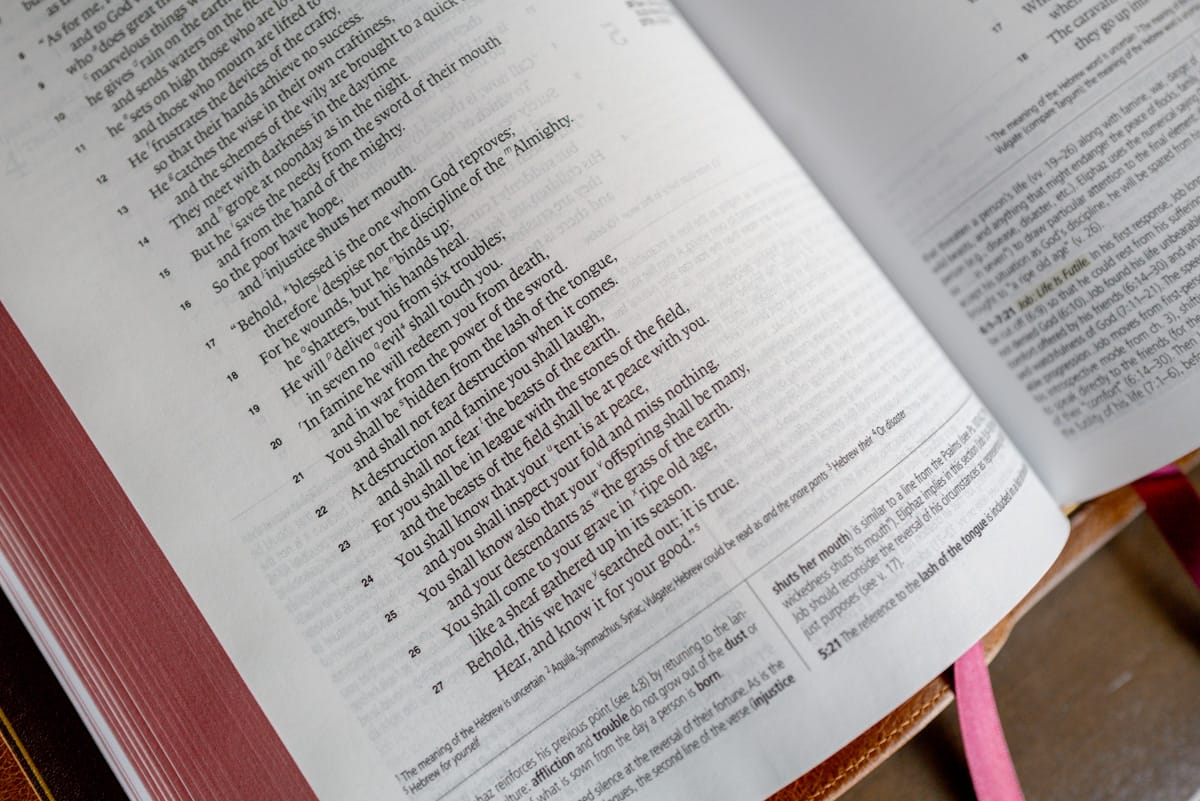
This 30 GSM Thin Opaque paper is also super smooth — there is a toothiness to the 31 GSM Thincoat Plus paper in my goatskin Heirloom Study Bible, whereas this 30 GSM Thin Opaque is silky and luxuriously smooth. This paper is more in line with the look and feel of the much older Heirloom Single Column Legacy I have in my collection, which I purchased back in 2017 sometime.
I have not taken the liberty of trying various pens or highlighters on this new 30 GSM Thin Opaque paper. This is my wife's study Bible and she has to make the decision as to whether or not she wants to mark it up. If she decides to, I will report back on how the paper handles ink.
Wrap Up
This isn’t a slight to the other Bible reviewers on the web, but the majority of the reviews of the ESV Heirloom Study Bible seem to be from the eyes of a pastor or preacher. It makes sense, really — those who will have their noses in such a deep book are likely to be those whose profession revolves around the book. No harm, no foul.
But the result is a range of reviews suggesting — or perhaps I’m just inferring — that the Heirloom Study Bible is more directly designed for preachers and pastors who need to build out sermons with study tools.

I don’t think there’s any reason to suggest you need to be a pastor or preacher to make the ESV Heirloom Study Bible part of your Bible study. The resources and study tools are written in a very welcoming manner, ensuring a wide variety of reading levels and levels of understanding can take something out of the scholarly articles. Images and charts are drawn up in an easy to follow approach, providing ample understanding for all people. And extra pieces, like the family records portion at the beginning of the Bible and the daily reading plan at the end, make for a Study Bible designed for all people.

If you’re set on taking your Bible study to the next level, then there’s no better study Bible on the market right now. The pristine printing by L.E.G.O. in Italy, the impeccable binding by Royal Jongbloed in the Netherlands, the seemingly endless array of study tools and materials, the perfect art gilding and goatskin leather, and the easy to read font and text designs make the Crossway ESV Heirloom Study Bible an absolute joy to use each day.
You can find the black, brown, and blue goatskin Crossway ESV Heirloom Study Bibles on EvangelicalBible.com. You can also find the black goatskin model on Amazon.
I’ll have a review of this wonderful Bible in the coming months as well. Stay tuned! ↩
A good example of this large amount of ink can be seen in the amount of show-through in large, full-page images. The reverse side of those pages aren’t illegible, but they are certainly less easy to read than a regular page. ↩